Singapore Defies Global Gloom with Surging Economic Growth [VIDEO]
The triple-A rated powerhouse at the heart of Asia whose economy is growing faster than all of its regional rivals thanks to a tightly controlled currency and booming exports isn't who you think it is.
A Moody's Investors Service report on Singapore published Tuesday highlights the resilience one of the world's only top-rate economies "despite the openness of its economy and its dependence on global trade and finance."
The report probably comes as no surprise to those who watch the country closely or regularly operate deals and business in Singapore, but it is easy to forget when we hear troubling reports stemming from Asia, namely China, on battening down the hatches, stockpiling cash and energy and of course producing slowing GDP growth and steps to curb inflation.
Singapore's economy expanded by 10 percent in the first three months of the year from the previous quarter and growth has averaged more than 6 percent over the past five years. On purchasing power parity terms, it's the richest nation in Asia and ranks as the top global economy by the World Bank in terms of ease of doing business.

Singapore's benchmark FTSE Straits Times Index has risen more than 7.3 percent this year, outpacing gains in Japan's Nikkei 225 (2.4 percent) China's Shanghai Composite (4.6 precent) and Hong Kong's Hang Seng Index (5.3 percent). It's currency, the Singapore dollar, is one of the best performing in Asia this year, having advanced nearly 2 percent against the US greenback.
But there have been bumps along the way.
The trade-dependent economy contracted 1 percent in 2009 as a result of the global financial crisis, but quickly rebounded to 14.8 percent in 2010 and 4.9 percent in 2011, on the strength of renewed exports.
Previous to this, real GDP growth averaged 8.6 percent between 2004 and 2007.
"Singapore's "very high" economic strength mainly reflects the trend of a high growth rate for an advanced economy, as well as high per-capita income," said Moody's. "Singapore's scores on these metrics have exceeded the 'Aaa' medians in both real GDP growth and per-capita income in terms of purchasing power parity over the last 10 years."
According to the International Monetary Fund's (IMF) "World Economic Outlook" report, published in April this year, the group also sees further growth for Singapore, as it predicts a 2.7 percent rise in GDP for 2012 and 3.9 percent growth in 2013.
Inflation has also been a concern, particularly given the high cost of vehicle permit ownership, which can run as high as $72,000 in the island city-state.
Consumer prices rose 5.4 percent last month and the persistent increase in the cost of living has forced Singapore's Monetary Authority and its central bank to compensate with policy changes, most notably in easing the trading band of the Singapore dollar on international markets.
Singapore overcame the odds considering it heavily relies on exporting pharmaceuticals and technology products to markets in Europe and North America. However, the aid of a notoriously robust regulatory regime and a remarkably corruption-free trading environment has helped significantly, as has "sound regulatory and supervisory frameworks have helped foster a strong and well-managed financial system," according to Moody's.
High Net Worth Individuals and Investment
"The substantial accumulation of public savings, along with fiscal prudence and a fully funded public pension system, supports the Singaporean government's strong financial position," Moody's added.
Indeed, the efficiency of investment coupled with "a competitive economy and investment regime, have led to a strong external position. Singapore has one of the world's largest net-asset international investment positions," added the ratings agency.
Singapore has the highest density of wealthy people in the world, says financial consultancy Wealth Insight.
The group revealed that Singapore has over 150,000 high-net worth individuals (HNWIs) worth more than $1m each and 2.9 percent of Singapore's population by the end of 2011.
Wealth Insight also hailed the resilience and prospects for the country saying that the high density of the HNWIs will prove instrumental in the expansion of Asia's banking sector and could even surpass traditionally offshore financial centres.
"By 2015, Singapore is expected to have gained significant ground on, and could even surpass, Switzerland as the world's largest offshore financial centre," said Wealth Insight analyst Andrew Amoils. "This will be fuelled by HNWI growth in the Asia-Pacific region and global clients moving their offshore funds from other financial centres to Singapore."
Challenges Ahead
As with every scenario, there will be challenges for Singapore to face in the long term.
Moody's says that the "challenges facing the authorities include containing consumer price and property inflation over the near term, and fostering a growth model that is driven by productivity and innovation over the longer term," despite a strong balance sheet ensures debt affordability and buffers external shocks.
In terms of Singapore's banking industry, another rating agency, Standard & Poor's agreed that while many aspects of the industry is at very low risk, economic imbalances could be the key the challenge the country faces.
"Economic imbalances are of "high risk", taking into account credit concerns from rising real estate prices; although strong household balance sheets continue to support repayments," said S&P in March this year. "[But] system wide funding is of 'low risk', reflecting some reliance on external borrowing, given Singapore's status as an international financial centre. Credit risk in the economy is of "low risk", reflecting a moderately high level of private sector debt, but supported by high income levels and conservative lending standards."
© Copyright IBTimes 2025. All rights reserved.






















